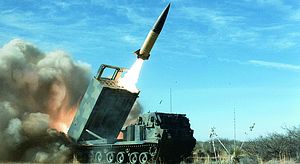The head of U.S. Pacific Command, Admiral Harry Harris, said that he wants the U.S. Army to create new ship-killing units to threaten U.S. adversaries’ surface warships in the Western Pacific including in the East China Sea and South China Sea.
“I believe that the army can do a lot in cross-domain fires,” the admiral said in remarks delivered at an event sponsored by Defense One on November 15 held in Washington D.C. “I think the army should be in the business of sinking ships with land-based surface-to-ship missile systems,” he noted.
“What the Army brings traditionally is what they always bring, which is mass and firepower and capability,” the admiral stated adding that the U.S. Marine Corps could play a similar role in the future. The central element of such a defensive strategy would be built around holding islands that can deny potential adversaries such as the People’s Liberation Army Navy (PLAN) access to the open waters of the Western Pacific.
“I think about an area where you put these weapon systems on places in the western Pacific; they would place at risk potential adversaries in the South China Sea, the East China Sea, the Sea of Japan,” the admiral said. “I think it is an important concept, and we ought to be thinking about it as we figure out how to maintain that edge over our adversaries in the region.”
In his remarks the admiral specifically singled out Chinese activity in the South and East China Seas. “I’m concerned about Chinese assertiveness particularly in the South China Sea and also in the East China Sea,” Harris said. “That said, the relationship with China on one level is actually good. I was in China several months ago and was treated extremely well.”
Possible weapon systems to be deployed include the M109A7 Paladin self-propelled howitzers, the M142 High-Mobility Artillery Rocket System and the Army Tactical Missile System, which will be upgraded with the capability to engage moving targets on land and sea — a so-called cross-domain capability — under the guidance of the U.S. Department of Defense Strategic Capability Office (SCO).
“By integrating an existing seeker onto the front of the missile,” U.S. Defense Secretary Ashton Carter stated in remarks on November 3, “[SCO is] enabling it to hit moving targets, both on land and at sea. With this capability, what was previously an Army surface-to-surface missile system can project power from coastal locations up to 300 kilometers [186 miles] into the maritime domain.” Next to making sure that the U.S. Army will have situational awareness of the waters, this would also require changes in U.S. Army doctrine.
As Steven Stashwick explained in The Diplomat (See: “The US Army’s Answer for an A2/AD Shield in Asia”) back in October, the U.S. Army has started working on denying a future adversary use of an area or domain via its ‘Multi-Domain Battle’ concept. “This translates to using land maneuver—i.e. ground forces—to both exploit and enable operations across air, sea, cyber, space, and the electro-magnetic spectrum,” he explained. In the Western Pacific, this could translate into an A2/AD umbrella made up of land-based capabilities on the first island chain.
It is also important to note that any new coastal defense role by the U.S. Army would have to be closely coordinated with regional allies. Japan is already working on an anti-access/area-denial operational concept with Japanese characteristics based on island defense and coastal batteries. In August, Japan also announced that it would develop a new land-to-sea missile to reinforce the defenses of remote Japanese-controlled islets in the East China Sea (See: “Deterring China: Japan to Develop New Anti-Ship Missile for Defense of Senkakus”).
































